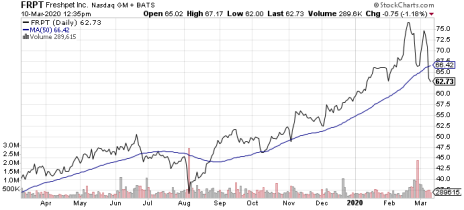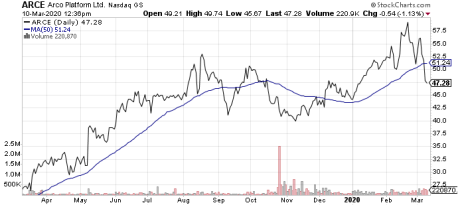CrowdStrike stock is one of three potential leaders I see for the inevitable market rebound. Here are two others - and why you should start buying them now.
When the market peaked on February 19 nobody thought it was at risk of falling 19% in the 13 days ending on March 9.
Previous viral outbreaks, including SARS (in 2003 and 2004), MERS (in 2012) and Ebola (2014 through 2016) were all contained by doing what people started to do when COVID-19 broke out. These steps include testing, screening at airports and other major hubs, isolating patients, encouraging healthy habits and some level of social distancing (i.e. fewer hugs, handshakes and parties).
Nevertheless, here we are. Increasingly, my question has become this: Is all the talk on social media, coverage from the media, and dramatic steps being taken by governments making this seem a lot worse than it really is?
[text_ad]
That’s a question/sentiment that I think is felt by many, especially as the line between pragmatic precautions and total hysteria becomes blurred.
Stepping back, what we know is this: The market was at an all-time high and had been able to shrug off dozens of other issues, until this one. People get viruses, but they are particularly freaked out by COVID-19, possibly because it is new, unknown, can spread through asymptomatic people and we don’t know if it will flicker out in warmer weather (SARS did just that).
I’m not saying we should ignore or downplay the risk. But I do question whether a nearly 20% correction is reasonable.
We know this will pass. How long that takes will determine exactly what the “new normal” looks like out there, and how quickly businesses and consumers bounce back.
Since there won’t be a perfect all-clear sign, the best thing investors can do is average into positions that they think could be the next leading stocks and that they are willing to hold through some turbulence.
Here are three on the top of my list, starting with the largest: CrowdStrike stock.
3 Potential Leaders of the Next Market Rebound
CrowdStrike (CRWD)
CrowdStrike is a $9.3 billion market cap company that provides cloud-based cybersecurity and endpoint protection solutions. Its platform currently deploys up to 10 modules through the cloud that secure and protect client endpoints, including laptops, desktops and IoT devices.
The company is different from much of the competition because it was born in the cloud, so is 100% developed for this delivery model. Because of its cloud-based model CrowdStrike’s Falcon platform can work off a single lightweight agent that runs on the endpoint and requires far fewer computing resources than competitor products.
In other words, CrowdStrike has a very efficient platform that offers both immense power and tremendous flexibility. That adds up to a good value proposition for customers in a large and growing addressable market that’s estimated at nearly $25 billion.
The company has been capturing market share, and acquisitions of other players in the market (Symantec, Carbon Black, Endgame, etc.) has created disruptions that analysts believe could strengthen CrowdStrike’s competitive position even more.
The best evidence of customer demand is growth. CrowdStrike has 4,561 customers (up 112% over a year ago), boasts 97% annual recurring revenue and is rapidly expanding sales with existing customers (net expansion rate was 120% in Q3). Fourth-quarter results are due out March 19, which means interested investors can get the latest scoop next week on potential coronavirus impacts, the departure of its co-founder and chief technology officer, and other relevant news.
Big picture, this is one of the fastest growing cybersecurity companies out there. Revenue was up 110% in 2019 and 88% in Q3 fiscal 2020 (reported December 5). That puts CrowdStrike on pace to grow by around 87% this year. Adjusted EPS is still negative, coming in at -$0.07 in Q3 and estimated to be near -$0.55 in fiscal 2020, but could turn positive in 2022.
The market correction has been rough on CrowdStrike stock, which is now trading near the lowest levels since it went public last June.
Freshpet (FRPT)
Freshpet is a $2.5 billion market cap company that sells pet food for dogs and cats using fresh, whole ingredients that are gently cooked without preservatives. In this context “fresh” means refrigerated, and therein lies one of the distinguishing characteristics of this company; Freshpet owns its own fridges.
This gives it a competitive advantage because most food retailers don’t want to manage a second group of fridges just for dog food. Freshpet has taken that responsibility off their shoulders. And that’s making it harder for competitors to gain a foothold in the industry. Freshpet is currently the biggest producer of fresh dog food in the United States. However, there are specialty companies gaining traction online, so Freshpet is clearly not the only player out there.
Most of the company’s revenue ($246 million in 2019, up 27%) comes from dog food sold in bag and roll formats. It’s been growing consistently because of its unique business model (company-owned fridges), rising pet ownership (70% of U.S households) and steadily increasing price-per-pound for pet food (up almost 50% since 2011).
Revenue should be up around 27% in 2020 and adjusted EPS should be around $0.40 (up from a loss of -$0.04 in 2019). The stock is roughly 23% off its all-time high and below its 50-day moving average line. But all things considered, FRPT has held up reasonably well during this correction.
Arco Platform (ARCE)
Arco Platform (ARCE) offers a disruptive, 100% subscription-based software platform for delivering integrated education content to K-12 private schools in Brazil, where, through March 5, there have been only eight confirmed cases of the coronavirus. The $2.6 billion market cap company prides itself on technology innovation and has the data to back up claims that its solutions help improve academic results.
Like most parents, Brazilians want their school-age kids to use tools that permit personalized learning, while giving some insight into progress and roadblock resolution. This is what Arco offers the Brazilian market, which is marked by mediocre academic results from many small and geographically distributed schools, which makes teaching staff somewhat inefficient.
Arco’s solutions offer schools a one-stop shop for both content and school management tools. While it has less than 10% market share today, Arco stands out in a crowded marketplace because the entire offering is integrated; schools don’t need to buy from different vendors and struggle to patch them together.
The business should continue to grow rapidly due to market share gains, acquisitions (Arco has made three in recent quarters) and pricing power. Revenue is seen up 26%, to $130 million, in 2019. Results come out on March 16 (next Monday), so this is another case where potential investors can watch and wait, while getting an update on the business climate in the very near-term. The stock looked to be breaking out in mid-February, but has been pulled back down into its established trading range during this market correction.
[author_ad]




